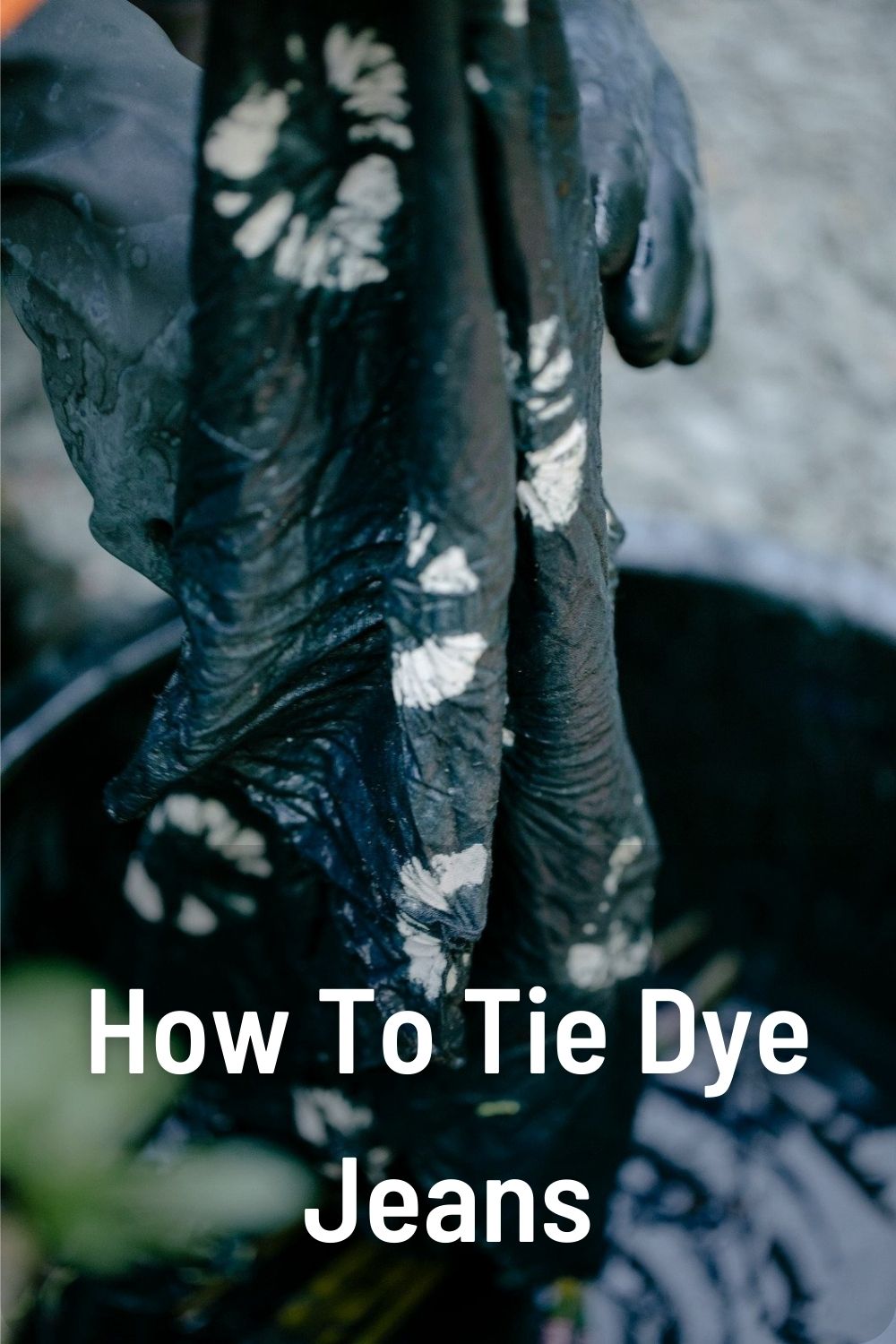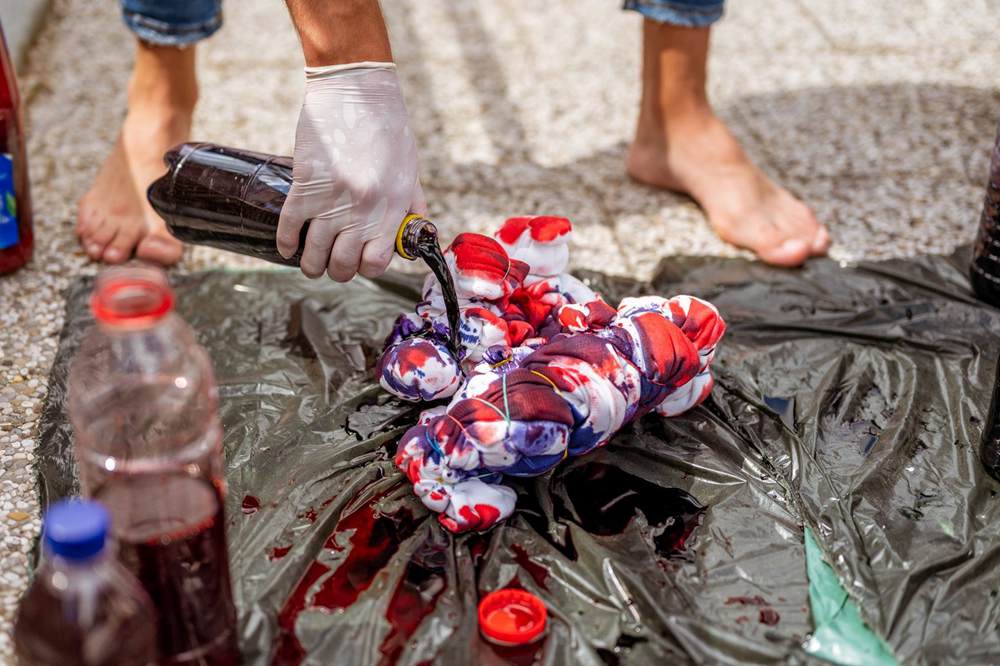
Tie-dyeing is a beloved technique for infusing clothing and fabrics with bright, colorful patterns. By tightly binding sections of the fabric and then dyeing it, the tied-off areas resist the dye, creating funky swirls, stripes, and bursts of color when unwrapped. It’s a fun and creative way to customize and revitalize old jeans. With some simple supplies and techniques, you can easily tie dye denim at home. This complete guide will walk you through everything you need to know for beautiful, vibrant results.
Table of Contents
Why Tie Dye Jeans?
Tie-dyeing has long been a popular way to embellish and modify clothing. When done on classic denim jeans, it transforms them into a stylish statement piece that shows off your originality. Some key benefits of tie-dyeing jeans include:
- Creativity – It allows you to design completely custom patterns and color combos. The options are endless!
- Customization – Tie-dyeing lets you revamp jeans to be truly unique to you.
- Self-expression – Your tie-dyed jeans become a wearable canvas showcasing your personal style.
- DIY fun – It’s an enjoyable craft project creating eye-catching jeans.
- Affordable – You can transform jeans you already own for the cost of supplies alone.
- Sustainability – Breathing new life into old jeans keeps them out of landfills.
Tie-dyeing is all about making your jeans distinctly yours. The colorful, smudgy patterns have an edgy, artsy look you can’t get anywhere else.
How to Pick Jeans for Tie Dyeing
Choosing the right denim is key to gorgeous results. Here are the jeans characteristics to look for:
- 100% cotton – For maximum dye absorption, opt for jeans made of 100% cotton, not stretchy blends.
- Medium to dark wash – Lighter washes don’t readily accept bright dye. Mid to dark blues dye best.
- Well-worn – Older, faded, worn denim absorbs dye better than stiff new jeans. Pre-washing helps soften fibers.
- Straight leg – Fitted or skinny jeans are harder to gather and tie. Relaxed straight legs tie-dye easier.
- No rips/tears – Holes will fray and cause dye leakage so look for intact denim.
- No embellishments – Remove any studs, jewels, appliques that may interfere with tying and dyeing.
Inspect your jeans for these attributes. Trouble spots like spandex, tears or adornments can sabotage the patterning.
Tie Dye Supplies Needed
Tie-dyeing jeans requires just a few supplies you may already have at home:
- Dye – Fiber-reactive, cold water dyes designed for cellulose fibers work best. They bond permanently to the cotton denim.
- Rubber bands – You’ll need bands in a range of sizes from micro to oversized to tightly tie off sections.
- Gloves – Protect your hands from stains with rubber or disposable gloves.
- Tarp or drop cloth – Work over an old sheet or tarp to catch drips.
- Squeeze bottles – For controlled dye application on tied sections. Recycled bottles work well.
- Salt – Table salt helps set and intensify the absorbed dye.
- Rags, paper towels – Useful for blotting excess dye as you work.
It’s also handy to have a small funnel for filling squeeze bottles, plastic wrap for masking off areas, and a spray bottle of water to dampen the jeans.
Tie Dye Techniques for Denim

One of the fun parts of tie-dyeing is trying out different patterning techniques. Here are some of the top ways to tie-dye jeans:
Spirals
This basic twisting technique yields classic circular motifs.
- Pinch a section of jeans and spiral the fabric strip tightly.
- Wrap rubber bands snugly around each end to secure the twist.
- Dye the spiral section the desired color.
- Remove bands after rinsing to reveal spirals.
Stripes
You can generate stripes by tightly scrunching or accordion folding areas.
- For random stripes, just scrunch up an area and wrap bands around each end.
- For uniform stripes, fold a section into narrow pleats and wrap tightly.
- Saturate the banded section with dye. The ridges resist dye.
- Rinse out bands to see stripes.
Sunbursts
These vibrant bursts of color start with a bullseye spiral pattern.
- Twist jeans section around your finger and wrap a band around the center.
- Continue wrapping larger bands outward every 1-2 inches while keeping the twist.
- Dye each section between bands a different color.
- Remove bands after rinsing to display the sunburst.
Marbling
This fun freehand technique yields swirling marbled effects.
- Scatter dye powder directly onto dampened jeans.
- Spray with water to dissolve, then manipulate dye into patterns with tools.
- Layer more colors for further blending and effects.
- Rinse well to reveal marbled look.
Step-by-Step Tie Dyeing Process
Once you’ve selected jeans, gathered materials and chosen a pattern technique, follow these steps:
1. Prepare the Jeans
Wash jeans well without fabric softener. This preps fibers to readily absorb dye. Soak jeans in warm water to fully saturate, then wring out. You’ll be working on damp jeans.
2. Tie Off Sections
Using your hands and rubber bands, tie or wrap areas of the dampened jeans according to your chosen technique. Bind tightly so dye cannot penetrate under the ties.
3. Mix the Dye
In squirt bottles, mix dye powder with very hot 130°F water according to package directions. Using hot water helps maximize color vibrancy.
4. Apply the Dye
Working over a tarp, squirt dye liberally on tied sections, flipping to saturate both sides. Apply a different color to each section as desired.
5. Set the Dye
Sprinkle salt generously over the freshly dyed jeans. Salt helps drive dye into fibers and binds it. Allow to sit 10-20 minutes.
6. Rinse Out Excess Dye
Rinse jeans under cold running water until water runs clear. Remove ties and bands carefully to avoid disrupting dye.
7. Additional Dyeing
For multi-color patterns, dye sections again with a new hue after thoroughly rinsing out the previous color.
8. Final Rinse
Rinse until rinse water is completely clear of excess dye. Wring out jeans and hang to air dry fully before wearing or washing.
With some creativity and practice, you can churn out all sorts of wildly patterned tie-dyed jeans!
Maximizing Your Results
Follow these handy tips for getting the most vivid, long-lasting results from your tie-dyed denim:
- Use very hot water when mixing fiber-reactive dye for maximum intensity.
- Make sure dye paste consistency is thick for concentrated color saturation.
- Apply dye liberally and flip jeans to saturate both sides equally.
- Sprinkle on plenty of salt after dyeing to help set the colors.
- Rinse well between colors to prevent bleeding and clouding.
- Air dry fully before washing to allow dyes to cure and bind properly.
- Wash in cold water after dyeing to prevent bleeding onto other items.
- Expect some mild color loss over time with washing. Re-dye to restore vibrancy.
Caring for Tie Dyed Denim
Taking good care of your hand-dyed jeans helps colors stay vivid. Follow these tips when laundering and wearing them:
- Wait 24-48 hours after dyeing before washing to allow dyes to fully cure.
- Always wash in cold water to prevent bleeding, fading and discoloration.
- Wash jeans inside-out. This reduces abrasion to the dyed outer surface.
- Wash separately from other garments to prevent any residual dye transfer.
- Line dry instead of machine drying to protect dyes from heat damage.
- For badges or spots, hand wash with a dye-fixing agent like Retayne.
- Expect some minor fading over time. Re-dye to refresh when needed.
With the right care, your artistic jeans will stay awesomely vibrant for many wears to come!
Common Troubleshooting Questions
If you run into issues as you experiment with tie-dyeing, here are answers to some frequently asked troubleshooting questions:
Q: How do you prevent dye from bleeding under the ties?
A: Wrapping rubber bands very tightly prevents leakage. Also use dye pastes thick enough that they can’t seep under bindings.
Q: Why are my colors turning out faint and dull?
A: Using sufficient hot water when mixing dye powder maximizes color vibrancy. Too much water dilutes it.
Q: How do you achieve crisper lines between colors?
A: Avoid overlapping dye between tied-off sections. Rinse very thoroughly between colors.
Q: What causes muddy color mixing or blotchiness?
A: Insufficient rinsing can cause dye colors to muddle together. Agitating too roughly can also disrupt patterns.
Q: How do you brighten up colors after washing?
A: Re-dyeing will restore faded hues. Use dye fixative like Retayne in the wash to protect colors.
Final Takeaways
Tie-dyeing is all about unleashing your creativity to make wearable art! With some simple supplies and techniques, you can easily transform old denim into eye-catching works of art. Experiment, be bold with colors and patterns, and most importantly, have fun making jeans that boldly express your style. Once you get the basics down, there’s no limit to the amazing designs you can dream up. So grab those jeans languishing in the back of your closet and breathe colorful new life into them with tie-dye!